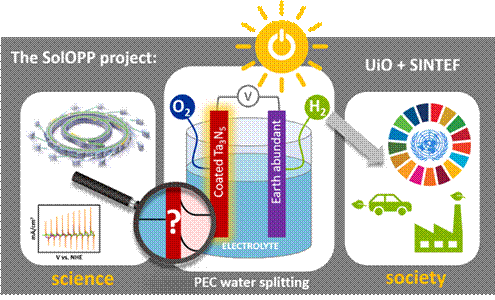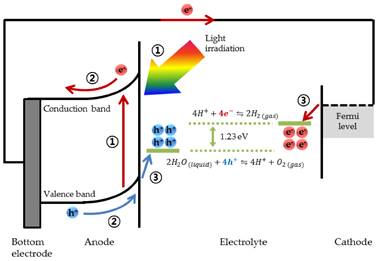1-2 master projects are offered in connection to the project "A highly efficient and stable electrode for solar-driven water electrolysis, interrogated by advanced operando and in situ techniques (SolOPP)", which was recently funded by the Research Council of Norway. The project is led by SINTEF, with UiO as a partner. Figure 1 is a graphical presentation of the project.

Figure 1: SolOPP is an interdisciplinary approach to address fundamental challenges that will ultimately lead to robust, efficient, and clean energy technologies.
Photoelectrochemical (PEC) water splitting is a promising and renewable method to produce hydrogen (H2) as a green energy carrier from solar light. It is an elegant way for water electrolysis, as the photo absorber is at the same time the electrolyser. The oxygen evolution side (anode) is the bottleneck of watersplitting. The optimal material for the anode is a semiconductor with bandgap around 2 eV and band edges favourably positioned relative to the energy needed for the oxygen evolution reaction (the bandgap should "straddle" the oxygen evolution reaction potential). Electrons are excited to the conduction band by solar light, and in the ideal case the band structure of the anode prevents recombination of holes and electrons, see figure 2. Holes move towards the surface of the anode to participate in splitting water molecules, while the electrons move through the circuit to the cathode to participate in H2 formation.

Figure 2: The principle of photoelectrochemical water splitting (From Jeong et al. Appl. Sci. 8:8 (2018) 1388)
The SolOPP project is focused on the promising electrode material Ta3N5, which already show excellent water splitting efficiency, but is limited by stability issues that reduces the lifetime of the device. Or in other words: it degrades in water... In SolOPP, we will develop innovative approaches to improve the stability, based on application of co-catalysts and protective coatings with closely tailored properties. The development will be aided by operando studies of the semiconductor/electrolyte interface using ambient pressure X-ray photoelectron spectroscopy (AP-XPS), combined with in situ transmission microscopy (TEM) and theoretical calculations.
The Master projects will have either XPS (Semiconductor physics group, MiNaLab) or TEM (Structure physics group, Forskningsparken) as the main technique:
- XPS will be used to investigate the anode band structure at surfaces and interfaces of Ta3N5-based anodes. XPS can give information about the absolute position of the valence band relative to the Fermi level, surface band bending and band offsets at thin film interfaces, as well as the chemical evolution of the material during watersplitting. In addition to "standard" XPS performed in ultra-high vacuum (UHV) at MiNaLab, the student will be given the opportunity to participate in experiments at international synchrotron facilities, where the interface between the anode and the liquid electrolyte can be studied during operation (operando), using ambient pressure XPS. The first synchrotron experiment is already scheduled at the MAXIV synchrotron in Sweden in Dec 2021.
- TEM will be used to investigate the anodes before and after exposure to the electrolyte and/or sunlight, and after operation. High resolution TEM and scanning TEM (STEM) can reveal the atomic arrangement of nanotubes, thin films, interphases and surfaces, Energy Dispersive Spectroscopy (EDS) provides information about the compositional elements present in the sample, while Electron Energy Loss Spectroscopy (EELS) can provide band gap measurements on the nanoscale across the interface.
In addition to the main technique, the master project can include other activities, such as macroscopic opto-electronic measurements, materials synthesis or device testing, depending on the candidate's interest and skills. The student will be included in the SolOPP project and participate in project meetings etc.
|
|
Ingvild Thue Jensen (XPS) Senior Scientist at SINTEF Materials Physics and part-time researcher in the Semiconductor physics group at UiO.
Annett Thøgersen (TEM) Senior Scientist at SINTEF Materials Physics and SolOPP project leader.
|
|
|
Athanasios (Sakis) Chatzitakis (Electrochemistry) Researcher in the group for electrochemistry at UiO (+ co-supervisor from the Semiconductor physics or Structure physics group, depending on the main technique.) |
|
|

